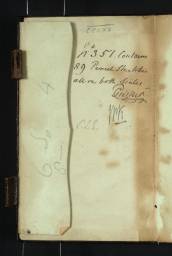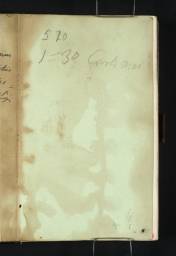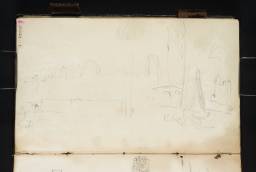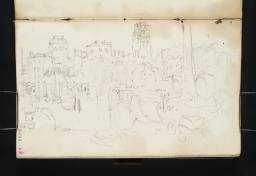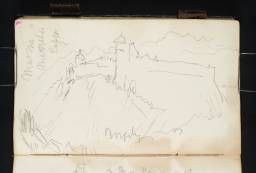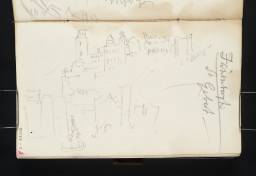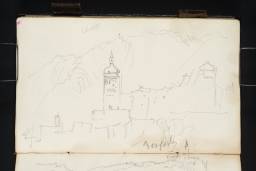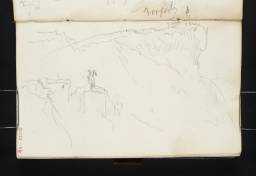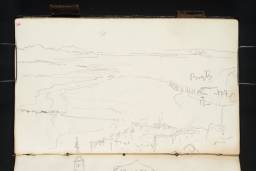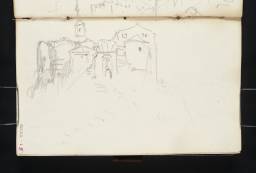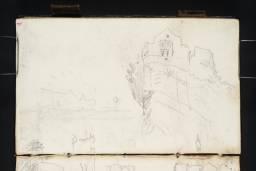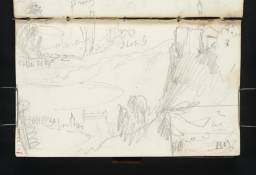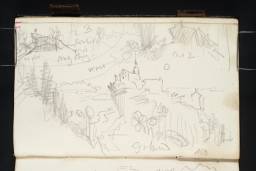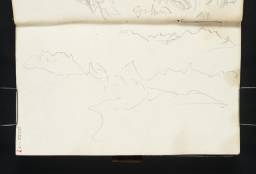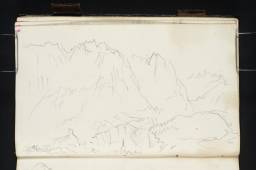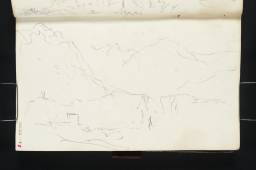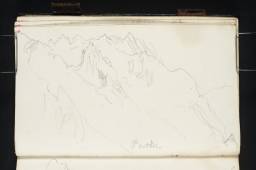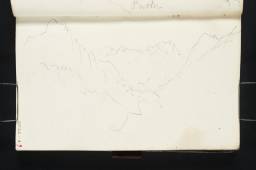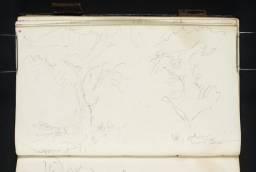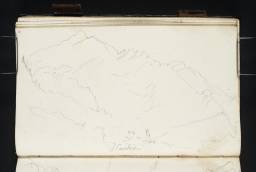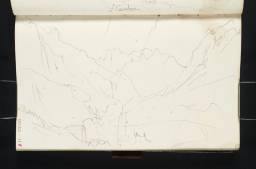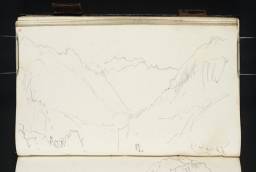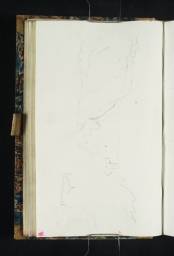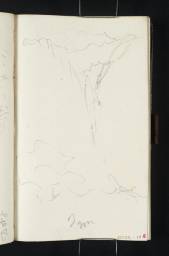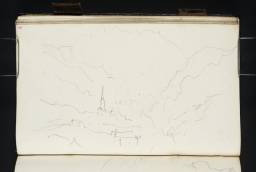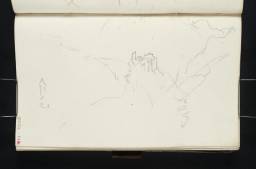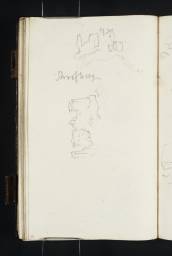Turner Bequest CCCXX 1–92
Sketchbook bound in boards, covered in black leather, blind-ruled with a single line around borders of both covers; three leather pencil loops
92 leaves of white wove paper, page size 149 x 89 mm; first and last leaves backed onto white wove endpapers continuous with inside covers over bellows-type pockets with flaps at fore-edges, all washed with pale green; pockets lined with blue wove paper and laminated with brown cloth; integral perpetual Dutch calendar set into last free leaf (see D41027–D41031); all edges gilt
Made by Jan Honig and Co., De Wever mill, Koog an der Zaan, Netherlands; various leaves watermarked partially with ‘J H’ and correspondingly ‘& C’
Supplied by Koopmans, Rotterdam: see printed frontispiece, folio 92 verso (D41028)
Numbered 351 as part of the Turner Schedule in 1854 and endorsed by the Executors of the Turner Bequest inside front cover (D41025)
Blind-stamped with Turner Bequest monogram on front cover, towards top left
Accepted by the nation as part of the Turner Bequest 1856
92 leaves of white wove paper, page size 149 x 89 mm; first and last leaves backed onto white wove endpapers continuous with inside covers over bellows-type pockets with flaps at fore-edges, all washed with pale green; pockets lined with blue wove paper and laminated with brown cloth; integral perpetual Dutch calendar set into last free leaf (see D41027–D41031); all edges gilt
Made by Jan Honig and Co., De Wever mill, Koog an der Zaan, Netherlands; various leaves watermarked partially with ‘J H’ and correspondingly ‘& C’
Supplied by Koopmans, Rotterdam: see printed frontispiece, folio 92 verso (D41028)
Numbered 351 as part of the Turner Schedule in 1854 and endorsed by the Executors of the Turner Bequest inside front cover (D41025)
Blind-stamped with Turner Bequest monogram on front cover, towards top left
Accepted by the nation as part of the Turner Bequest 1856
Exhibition history
References
This commercially produced Dutch pocketbook is filled with drawings made on the long journey from the North Sea coast to the Adriatic, accurately encompassed by the title Finberg gave it: ‘Rotterdam to Venice Sketch Book’.1 Albeit assigning an approximate date of 1835–40, he noted a letter of 24 August 1840, written in Rome by a recent travelling companion, signed ‘E.H.’, and sent to Turner in Venice. The writer ‘had accompanied Turner down the Rhine’ and ‘parted company with Turner at Bregenz, on the Boden See, “E.H.” and his wife going through the Viâ Mala to the Splugen, Turner bound for Venice, viâ Innsbruck and Landeck. Perhaps this sketch book may belong to this very journey.’2 The friendly letter, now untraced,3 has since been inferred to have been from the artist’s cousin Henry Harpur and his wife Eleanor,4 as discussed in the overall Introduction to the tour; its key point is the mention of Bregenz, at the western tip of Austria, which Turner is only known to have recorded in the present sketchbook and a handful of related compositions on coloured papers; see under folio 2 verso (D32266).
By 1930, Finberg was confident of the connection and thus the dating, which has been accepted by subsequent scholars:5
Thanks to this letter we know that Turner was at Bregenz on the 10th or 11th of August, and that he was on his way to Venice. The sketchbook he carried in his pocket – it had been bought in Rotterdam – shows that after leaving Bregenz he went through the Arlberg to Landeck, Meran, and Botzen (Bolzano), and then as he had already travelled twice between Trient [Trento] and Venice, he went this time to Brixen (Bressanone), and through the Dolomites to Belluno and Treviso to Venice.’6
In reviewing the Venice subjects he had listed in his 1909 Inventory, Finberg observed that the earlier part of the sketchbook included views ‘at Rotterdam (pp. 1, 2) and at Bregenz (p. 4a), but apparently none on the Rhine; if any were made they are probably in another book. From Bregenz Turner went to Landeck, Merano, Bolzano, Bressanone (p. 31), Dobbiaco, and through the Dolomites (38, 39, etc.) to Belluno (66a–71), and through Serravalle (75a) to Venice. The Venice sketches begin at p.76a’.7 In private annotations to the Inventory, he had speculated on a more detailed route from ‘Innsbruck to Brixen – Brunico – Dobbiaco – Pieve de Cadore – Longarone – Belluno – Serravalle – Mestre | How did he get from Serravalle to Mestre? Through Treviso.’8 It is unclear whether he recognised sketches of Brunico (Bruneck) and Pieve specifically; views of them both are identified in the present catalogue.
The subjects mentioned are set out in a more detailed outline of the route below. In terms of the perceived gap between Rotterdam and Bregenz, this is largely accounted for by Turner’s use of separate sheets for views on a short detour along the Mosel and apparently also on the Rhine as he headed south with the Harpurs, as catalogued here in a parallel subsection.9 Cecilia Powell has noted that Turner left London on the crossing to Rotterdam on 1 or 2 August 1840, giving a concise summary of what followed:
Here he bought a sketchbook [see also the technical notes below] and would thence have followed a familiar, and efficient, route up the Rhine; by this period it possessed an excellent steamer service. After pausing for a nostalgic detour on the Mosel he headed south, passing through Heidelberg and Bregenz on Lake Constance. From there he made briskly for Innsbruck, crossed the Alps over the Brenner Pass, revisited Bolzano (buying three further sketchbooks) and travelled along tortuous mountain roads and valleys through the Dolomites to Belluno. He arrived in Venice on 20 August.10
A map presented by the Dutch Turner scholar Fred Bachrach without further comment11 indicated that Turner ‘travelled by road from Rotterdam to Cologne through Holland. However, there are no sketches recording such a journey and Turner may equally well have travelled quickly up the Rhine by steamer’, as Powell has observed,12 before turning off at Koblenz for the brief Mosel interlude. As noted below, Powell’s proposed Innsbruck and Brenner Pass route is here superseded owing to newly identified subjects along a different itinerary.
Rotterdam itself is seen on folios 1 verso and 2 recto (D32264–D32265). Next, after the long gap of about 250 miles, comes Heidelberg (folio 3 recto; D32267). From there, Turner likely travelled established routes through southern Germany, about seventy miles via Heilbronn to Stuttgart,13 and then about 110 more through Ehingen, Biberach and Ravensburg to Friedrichshafen, on the shores of Lake Constance (the Bodensee) around twenty miles north-west of Bregenz,14 where he next used this sketchbook for several sketches; see under folio 2 verso (D32266).
The many sketches which follow between folios 7 recto and 76 recto (D32275–D32411) were mostly characterised as ‘Mountains’ by Finberg, with occasional identifications and transcriptions of the place names noted by the artist, some clearer than others.15 Between folios 7 recto and 10 recto (D32275–D32281) the route through Austria is presumably south-east through the rugged Vorarlberg Alps from Bregenz towards Sankt Anton am Arlberg at the western end of Tyrol on folio 10 verso (D32282), the next subject to be readily identified by its inscription; at the end of roughly sixty miles, Landeck (see folio 16 verso; D32294) lay not far beyond.
There are no identified views of either Innsbruck or the Brenner Pass, as inferred by Finberg and Powell; this part of the route was likely implied by an inscribed sketch view in the early stages of the book (folios 24 verso–25 recto; D32308–D32309) of the Franzensfeste fortress, just north of Bressanone (Brixen) in the Dolomites, and south of the pass ‘between Innsbruck and Botzen’ (otherwise Bozen or Bolzano) as Finberg noted.16 Turner had drawn at Innsbruck on his way to Venice in 1833 and again as he returned, in the Vienna up to Venice and Venice up to Trento sketchbooks (Tate; Turner Bequest CCCXI, CCCXII);17 see also the 1843 Dover, Rhine and Innsbruck (?) sketchbook (Tate; Turner Bequest CCCIX). However, the Franzensfeste sketch appears to be a random intervention among existing mountain and castle subjects.
Given the generally consecutive though occasionally haphazard sequence of inscribed or otherwise recognisable views from Landeck onwards, and assuming Turner did not double back on himself for considerable distances, it seems that he instead turned south from Landeck to the Passo di Resia (Reschenpass) leading from the Austrian Tyrol into South Tyrol (Alto Adige or Südtirol) in what is now northern Italy, and then east towards Merano (Meran), around seventy miles along two sides of a notional rough square (rather than east to Innsbruck and then south, along the opposite sides).18
As Murray’s 1837 Handbook for Travellers in Southern Germany noted, this option would have used an ‘excellent road, lately improved by the Austrian government’ along the upper valley of the Inn,19 by way of Pfunds, beyond which the Pass of Finstermünz ‘yields in grandeur to the Via Mala alone’.20 The key to this part of Turner’s itinerary is that folios 23 verso and 24 recto (D32306–D32307) show the Finstermünz or Altfinstermünz fortress guarding the old road along and over the Inn. The ‘improved’ route continues past it through Nauders to the Passo di Resia, and then south to Sluderno (Schluderns) before bearing east for Silandro (Schlanders) and Merano (Meran)21 along the valley of the Adige. Just before Sluderno he drew distinctive buildings at Malles Venosta (folio 24 verso; D32308). Murray’s guidebook noted that twenty castles could be seen from Merano (folio 31 verso; D32322),22 and the valley approaching it had been lined with them; Turner’s rapid sketches are littered with what appear to be impressive ruins.
From here it was a short journey about twenty miles south-east to Bolzano (Bozen, or as it was often then given, Botzen), where he paused long enough to make or begin several watercolour studies on grey sheets, although there are no directly related pencil sketches in the present book (see under folio 29 verso (D32318). As Finberg observed, rather than taking the route south to Trento towards Venice as he had in 1833, Turner now took the unfamiliar road through the dramatic Dolomites, initially north-east to Bressanone (Brixen; folio 31 recto; D32321), then, passing Franzensfeste as discussed above, he reached Brunico (Bruneck; folios 34 verso–35 verso; D32328–D32330). From there the road zig-zagged towards the south-east via Dobbiaco (Toblach), Landro (Höhlenstein; folio 59 recto; D32377), the Ampezzo district (folio 38 recto; D32335) around Cortina and San Vito di Cadore (folio 48 recto; D32355).
He paused long enough at Pieve di Cadore (folios 50 recto and verso; D32359–D32360), something like 100 miles from Bolzano by this route, to see the birthplace of one of his lasting influences, the great Venetian painter Titian. From there the road turned south, following the River Piave via Ospitale di Cadore (folios 36 verso, 37 recto; D32332–D32333) and Fortogna (folio 60 verso; D32380) to Ponte nelle Alpi (then called Capodiponte; folios 60 recto, 65 verso; D32379, D32390) before pausing after about twenty miles at Belluno (see under folio 66 verso; D32392); here he drew the town picturesquely situated town and its backdrop, the spectacular peaks of the Dolomites through which he had just travelled. From there it was a straightforward journey south for a last sixty miles, with a few more identifiable views (folios 72 verso, 73 verso; 75 verso; D32404, D32406, D32410) before the Veneto plains, Treviso and the edge of the Lagoon at Mestre (with a last mountain sketch near the end of the book, on folio 92 recto; D32443).
After nearly three weeks and 700 miles or more of river and road travel from the North Sea coast through Holland, Germany, Austria and northern Italy, Turner arrived for the third and final time at Venice. Aside from a stray view of the church of Santa Maria della Salute, across the Grand Canal from the Hotel Europa or (Palazzo Giustinian) where he was staying (folio 17 verso; D32296), and likely a less distinctive study on folio 22 recto (D32303), the sketch of the Bridge of Sighs on folios 76 verso–77 recto (D32412–D32413) is the first of the Venetian subjects which fill the rest of main body of the book as far as folio 91 verso (D32412–D32441; see also inside the back cover, D41031).
These are perhaps the first drawings he made on this occasion, largely refamiliarising himself with well-known sites close to the centre after seven years, including at least one walk around the Piazzetta adjoining the Piazza San Marco (St Mark’s Square), and a boat trip on the Bacino. Some related views run in short sequences before others intervene, suggesting the book was used on more than one occasion, or the artist was not concerned to use the pages in strict order. The presence of scaffolding around the spire of the campanile of San Mark’s is an important aid to dating these and other drawings to 1840 rather than 1833, as discussed in the tour’s Introduction.23
The Bridge of Sighs is again the focus on folio 90 recto (D32439), and the Rialto Bridge is the viewpoint for an isolated sketch on folio 78 recto (D32415); otherwise a restricted view of the church of Santo Stefano on folio 91 verso (D32441) is the only subject much removed from St Mark’s or the Bacino. There are views around the Piazzetta on folios 77 verso, and 79 verso–82 recto (D32414, D32418–D32423). From here, Turner may have taken straight to the water to make waterfront views around the Bacino on folios 82 verso–86 recto (D32424–D32431). Folios 88 verso and 89 recto (D32436–D32437) form a panorama along the Molo and the Riva degli Schiavoni waterfront off the Palazzo Ducale (Doge’s Palace), while folios 78 verso and 79 recto (D32416–D32417) were drawn near the Bacino entrance to the Grand Canal in the vicinity of the Europa, from a balcony of which Turner made connected studies looking east and south across the water on folios 86 verso and 87 recto (D32433).
There is also a brief sequence of views in and around the Porta della Carta entrance to the courtyard of the Doge’s Palace, off the Piazzetta (folios 87 verso, 88 recto, 89 verso, 90 verso; D32434–D32435, D32438, D32440). During this last fortnight in Venice, Turner also filled the Venice and Botzen sketchbook and about a quarter of the Venice; Passau to Würzburg book (Tate; Turner Bequest CCCXIII, CCCX) with pencil sketches of the city and the waters around it; there are also large numbers of colour studies on detached sketchbook leaves and separate sheets associated with the tour, as discussed in the overall Introduction. Andrew Wilton noted a connection between one of these and a pencil sketch here (folio 91 verso; D32441) as another key to dating them to 1840.24
One of the occasional ephemera kept with the Turner Bequest, a fellow artist’s visiting card, has been preserved loose inside the back cover pocket and is catalogued here (D41032); it dates from a few years later, and its presence is doubtless entirely fortuitous.
Transcribed in full in Finberg 1930, pp.119–21, the source for John Gage, Collected Correspondence of J.M.W. Turner with an Early Diary and a Memoir by George Jones, Oxford 1980, pp.178–9 letter no.236.
See George 1971, pp.86, 87, and subsequent sources, albeit queried in Gage 1980, pp.178 note 4, 192 note 3.
Undated MS notes by Finberg (died 1939) in interleaved copy of Finberg 1909, Prints and Drawings Room, Tate Britain, II, opposite p.1031; see also similar notes in a standard copy in the same location, p.1029.
Powell 2003, pp.32–3; see also Warrell 2014, p.188; for a slightly more detailed account mentioning some individual locations, see Powell 1995, p.65.
Powell 1995, p.81 note 6; see also Bachrach 1994, p.26, where various other sketchbooks containing Dutch material are incorrectly associated with this tour, having since been redated.
Technical notes
How to cite
Matthew Imms, ‘Rotterdam to Venice Sketchbook 1840’, sketchbook, September 2018, in David Blayney Brown (ed.), J.M.W. Turner: Sketchbooks, Drawings and Watercolours, Tate Research Publication, December 2019, https://www

